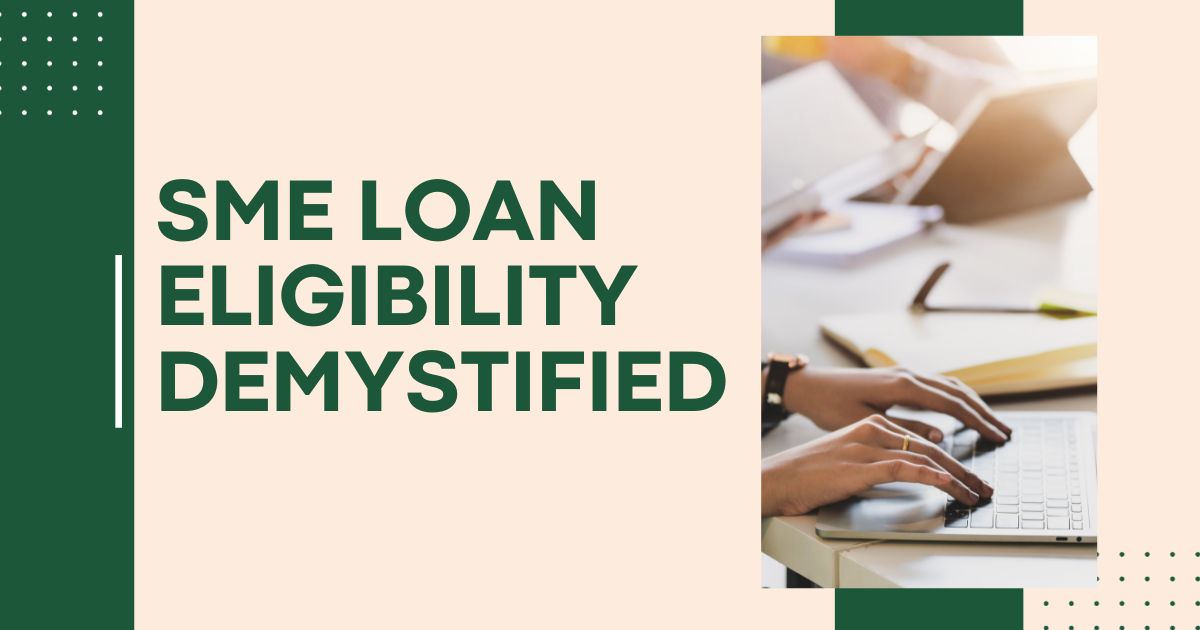In the Indian economy small and medium-sized enterprises play extremely important roles. They are the strong pillars of new innovation, economic expansion and the creation of jobs. SMEs commonly face difficulties when trying to obtain the financing they need to start or expand their business. In this article, we describe the role of SME loans. We will simplify the SME loan eligibility process so that you can quickly understand how to be eligible for business funding.
What Are SME Loans?
Small business loans generally known as SME loans. These types of loans are financial instruments built to assist small and medium-sized enterprises in fulfilling a range of costs. These costs may include investing in working capital, buying machinery, recruiting staff or growing the company. Government-running loans, credit lines and term loans are just a few of the different kinds of SME loans available. Banks, credit unions, internet loan options and government organizations offer these loans.
Why Do SMEs Need Loans?

SMEs may need loans for a variety of reasons:
- Starting a Business: Entrepreneurs often need funding to get their business off the ground. This can include expenses like securing a location, buying inventory, and initial marketing efforts.
- Expanding the Business: Successful businesses may want to grow and expand, which often requires additional funding. This could involve opening new locations, adding products or services, or increasing production capacity.
- Managing Cash Flow: SMEs may experience cash flow issues due to seasonal fluctuations in business or delayed payments from customers. Loans can help cover these gaps.
- Purchasing Equipment: Many businesses need specialized equipment or machinery to operate. Loans can be used to acquire these assets.
- Hiring and Training Employees: As businesses grow, they often need to hire and train more staff. Loans can cover the costs associated with this expansion.
Now that we understand the importance of SME loans, let’s demystify the process of qualifying for one.
Qualifying for an SME Loan
If you want to qualify for an SME loan that doesn’t have to be a complicated or intimidating process. It should include a summary of your projected earnings, future business plans and corporate goals. Financial institutions want to know that you have a clarified business plan and a strategy in place to repay the loan.
1. Credit Score
Your personal and business credit scores play a significant role in your loan eligibility. Lenders use these scores to assess your creditworthiness. A higher credit score reflects responsible financial behaviour, making you a more attractive candidate for a loan.
To boost your credit score:
- Pay bills on time.
- Keep credit card balances low.
- Avoid opening too many new credit accounts.
2. Business Plan
A well-prepared business plan is essential. It should outline your business goals, strategies, and financial projections. Lenders want to see that you have a clear vision for your business and a plan to pay back the loan. Your business plan should cover:
- An executive summary.
- A description of your business.
- Market analysis.
- Financial projections.
- Marketing and sales strategies.
3. Financial Statements
Lenders will scrutinize your financial statements to understand your business’s financial health. It should include an overview of your financial projections, plans, and corporate goals. Lenders want to know that you have a clarified business plan and an action plan in place to repay the loan.
4. Collateral
Collateral is an asset you can pledge to secure the loan. This asset provides security for the lender in case you can’t repay the loan. Common forms of collateral include real estate, equipment, or accounts receivable. It’s important to know that not all SME loans require collateral, but having it can improve your eligibility.
5. Business Experience
Loans for companies with established owners have a higher chance of being approved by lenders. If you are new to the business you might want to wait to apply for a loan until you have more experience in your field. Loan providers prefer that you have the expertise and skills needed to run a profitable company.
6. Debt-to-Income Ratio
The ratio of your income to debt serves as an indicator of your debt management skills. Lenders calculate this ratio by comparing your monthly debt payments to your monthly income. A lower ratio suggests you can comfortably manage additional debt.
7. Legal Structure
The legal structure of your business can affect your eligibility for certain types of loans. Sole proprietorships, partnerships, LLCs, and corporations all have different characteristics that lenders consider.
8. Industry and Market Conditions
Certain industries bring more risks than others, and economic conditions can shift over time. When analyzing loan applications, funding sources take these things into review. Be prepared to demonstrate that your business is well-positioned within its industry.
9. Repayment Ability
Lenders want to ensure that you have the ability to repay the loan. They may consider your cash flow, financial reserves, and the terms of the loan. A well-structured loan with manageable repayment terms is more likely to be approved.
10. Loan Purpose
Different loans are designed for specific purposes. Make sure the loan you are searching for is suitable for what your business needs. For example, if you are interested in purchasing equipment then apply for equipment financing instead of a working capital loan.
Types of SME Loans

There are various types of SME loans, and the one that suits your business depends on your needs and eligibility. Let’s briefly discuss some common types:
1. Term Loans
Term loans are the most common type of SME loans. They provide a lump sum of money that you repay over a set term with fixed interest rates. These loans are suitable for various purposes, such as expanding your business or purchasing equipment.
2. Lines of Credit
A business line of credit works like a credit card for your business. You’re approved for a certain credit limit, and you can borrow as needed. Interest is only charged on the amount you use. This is handy for managing cash flow or covering unexpected expenses.
3. Equipment Loans
If you need to purchase machinery, vehicles, or other equipment, consider an equipment loan. The equipment itself often serves as collateral for the loan.
4. Working Capital Loans
Working capital loans are designed to cover day-to-day operating expenses. They’re useful for businesses with seasonal fluctuations or those experiencing temporary cash flow issues.
The Loan Application Process

1. Choose a Lender
Choose a lender who provides the specific kind of loan you need and is easily available to your company. A traditional bank, a digital lender, or a credit union could be used.
2. Gather Documents
Prepare all required documents, like your business plan, accounting records, and any other documents required by the loan provider. At this stage, becoming systematic and organized can help to speed up the loan process.
3. Complete the Application
Complete the loan application with complete and accurate profile details. Check your application multiple times to avoid errors that could slow down the approval process.
4. Wait for a Decision
Your application will be reviewed by the loan provider, who may request sometimes additional information or clarification. Be patient during this process and be prepared to answer questions or provide additional documentation when required.
5. Review the Offer
You can accept and reject the loan after reading the offer. If you agree the loan provider will guide you with the next steps which usually include signing an agreement.
6. Accept or Decline
After reviewing the offer, you can choose to accept or decline the loan. If you accept, the lender will provide instructions on the next steps, which typically include signing an agreement.
Conclusion
Qualifying for an SME loan could seem to be a difficult process, but with careful planning and a knowledge of the key factors that financiers consider the process becomes more manageable.
Remember to work to raise your credit score, develop a solid business plan maintain accurate financial records. This increases your chances of receiving the funding needed to start or grow your small or medium-sized business. SME loans are an important asset for business owners and by demystifying the eligibility process we hope to help businesses to succeed and contribute to the Indian economy.
FAQ
Q.1 Do all SME loans require collateral?
No, not all SME loans require collateral. Collateral is an asset that provides security for the lender, but many loans, such as lines of credit, don’t require it. Whether or not collateral is needed depends on the loan type and lender.
Q.2 How does my business experience affect loan eligibility?
Lenders often prefer businesses with experienced owners as it shows they have the knowledge and skills to manage a successful business. Gaining experience in your industry before applying for a loan can improve your eligibility.
Q.3 Does my business’s legal structure impact loan eligibility?
Yes, your business’s legal structure can affect your eligibility for certain types of loans. Sole proprietorships, partnerships, LLCs, and corporations all have distinct characteristics that lenders consider when evaluating loan applications.
Q.4 Can I qualify for multiple SME loans at the same time?
Qualifying for multiple SME loans at the same time is possible but generally not recommended. Multiple loans can lead to increased debt and financial strain. Lenders may also consider your existing debt when assessing your ability to repay a new loan.


